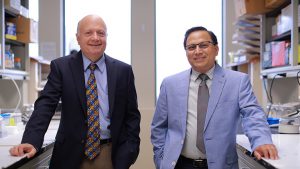By age 50, one in two people will have developed nodules within their thyroid.
Most aren’t cancerous, but when a biopsy is inconclusive, the next step is often removal of the entire butterfly-shaped gland, even though the odds are in favor of a benign tumor.
“Very few people will be satisfied to leave something in their neck not knowing what it is, especially if it has a chance to be cancer. This goes for patients and physicians,” said Dr. Juan Jaume, an endocrinologist and professor of medicine at The University of Toledo. “Because of that we are many times removing thyroids for no reason. But we don’t know that until we do the procedure.”

Dr. Juan Jaume, left, endocrinologist and professor of medicine, and Dr. Shahnawaz Imam, assistant professor of medicine, demonstrated a new, highly accurate way to rule out thyroid cancer in otherwise inconclusive biopsies and eliminate unnecessary diagnostic surgeries.
UToledo researchers may have discovered a way to eliminate those unnecessary diagnostic surgeries.
By looking at the prevalence of a specific immune cell, a team led by Jaume has demonstrated a new, highly accurate way to rule out cancer in otherwise inconclusive biopsies.
The findings, published in the journal Frontiers in Oncology, builds on an earlier discovery from the group that linked immune cells known as “double-negative T-cells” with thyroid cancer.
The long-term hope is that those double-negative T-cells might provide a new pathway for developing an immune-based therapy for thyroid cancer and potentially other cancers in which those immune cells are overexpressed.
In the meantime, their heightened presence in thyroid cancer suggested it could be a useful biomarker.
To test that theory, Jaume and Dr. Shahnawaz Imam, an assistant professor of medicine, analyzed immune cells collected by fine needle aspiration — the standard method used to biopsy thyroid nodules — from patients who ultimately had their thyroids removed.
Normally, double-negative T-cells constitute 1% to 5% of all circulating T-cells.
In patients whose tumors were confirmed to be cancerous, the double negative T-cells made up more than 9% of the total T-cell count.
None of the patients who had less than 9% of double-negative T-cells were found to have thyroid cancer.
“We may now have a way of predicting which of these tumors with inconclusive diagnosis as per the eye of the pathologist under the microscope are malignant,” said Jaume, director of UToledo’s Center for Diabetes and Endocrine Research and the study’s senior author. “There is nothing else out there that can give you this specificity in the diagnosis of thyroid cancer, short of removal.”
Located at the base of the neck, the thyroid produces vital hormones that control metabolism. When part or all of the thyroid is removed, those hormones need to be replaced by synthetic versions. If the entire thyroid is removed, individuals will be on thyroid hormone replacement therapy for the rest of their lives.
The National Institutes of Health estimates 44,000 new cases of thyroid cancer will be diagnosed this year, with women being three times more likely than men to develop the disease.
Though most thyroid cancers are highly treatable, conclusively diagnosing them without surgery can at times be tricky.
Of the 600,000 fine-needle aspirations performed annually in the United States roughly one-fifth come back with atypical features that could — but don’t necessarily — suggest cancer.
About 70% of those nodules are ultimately discovered to be benign after removal of the thyroid.
“It is extremely frustrating for patients to undergo surgery despite there being no cancer,” said Imam, the study’s first and corresponding author.
While there have been other molecular profiling techniques that attempt to predict whether nodules are cancerous, Imam said they tend to return a fair share of false positives.
“The primary goal for developing this technology is to correctly identify the benign thyroid nodule,” he said. “Our test identifies the non-cancerous benign thyroid nodule with 100% specificity, thereby preventing unnecessary diagnostic thyroid surgeries and ruling out the risks of thyroid cancer.”
Though testing for those immune cells is currently a complicated undertaking, the team is working toward developing a simpler, more cost-effective test that could be incorporated into standard diagnostic laboratories.
Jaume and Imam were recently invited to give an oral presentation on their work at the Endocrine Society’s annual meeting in Atlanta.